 home coil info products ordering
home coil info products ordering
Loohan Communications Office
Orgone Technical Bulletin #37
started Feb., 2011
Working with The Committee
in the creation of orgone devices
Committee, The: see glossary
If, for example, you want to make Strontium-Barium orgonite and Violet Flame orgonite, you need to have The Committee program the resin as it cures. These people do not have phone numbers or email addresses, if you know what I mean. You will have to call on them mentally. [Update: Normally for standard programs, and often more, call on Chemmerbuster or email me!]
But before you even try pouring real resin, as a test ask The Committee to pgm a crystal or stone or piece of metal for you with some free pgms. Let them choose the pgms unless you have a particular thing in mind. If you are unsure whether the programming happened, email me. Or skip the test and just email me in advance to line up any resin programming. Sometimes negative entities have been known to block people trying to connect to The Committee. Let's make sure you are connected before you pour resin.
With the S-B & VF pgms (and many other resin pgms) it is not necessary to add metal shavings or rocks. Just the specified powder mixes. No matter how much I stress this, I constantly get people asking me how they should incorporate such things, and I constantly tell them don't unless you are "inspired" to.
I usually no longer add such things to smallish enviro-gifts like TBs and ice cubes. I constantly do add all sorts of things when making more complex devices, though.
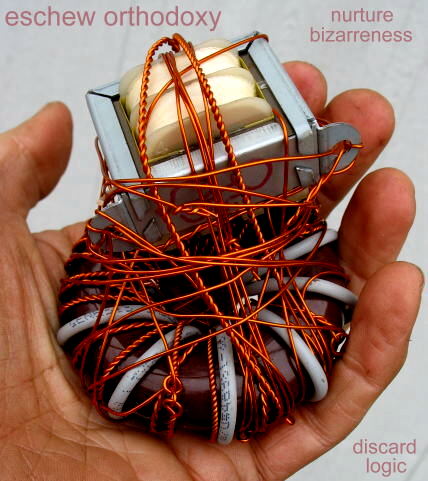 I never make any complex devices anymore except as I am guided to by The Committee.
I never make any complex devices anymore except as I am guided to by The Committee.
I let them tell me what objects to set aside, what mold to use, how to make coils and where to place them, etc. In fact most ingredients are placed with great precision, although there may be no geometry, symmetry, or discernable logic to the design.
Now, not everyone can do this, but a few people can and have made very impressive orgone devices with the help of The C. And it is for them that I write this OTB, and for them that I have the advanced tech forum (read the blurb before applying).
On the other hand, if you are not one of the few who will be able to work creatively with The Committee, you can still make larger devices that are excellent by most standards merely by pouring layers of the free pgms.
[Update Nov. 2012: Rant: If that is the case, I do not recommend that you throw a hodge-podge of ingredients into your resin. If you are not guided by some proper intuition, you are just wasting resources and your product will be wimpy. You should stick to basic stuff with few ingredients, and get the free programs. I continually get emails from people who don't comprehend that, unless you are particularly talented, you are not likely to improve on just plain resin and a pinch of aluminum powder for the Nov2012A Program, or just resin with cocoa for the Strontium-Barium Program. If you are a beginner and have never poured resin before, for crying out loud, don't think in terms of throwing crystals and stuff in to "make it more potent". The technology has evolved well beyond that. Crystals and things still have a place, so save them for when you are familiar with crafting. If you have never poured resin before, just make the programmed paper cup TBs first. Even if you screw things up, you will probably still end up with a tossable item that will work. Meanwhile, you will get experience working with resin so you are less likely to screw up a fancy project.
And I still make lots of paper cup TBs exactly as I recommend others do. They are important to spread around.]
By looking at the exterior of many of my devices, for example this chem-buster, you might get the idea I am into symmetry. Yeah, often external symmetry. But in recent years the interiors of my larger devices are wildly chaotic and unbalanced-looking. For example this CB contains within it the coil/donut on this page,as well as a number of other bizarre items and lopsided ingredients, with no regard to symmetry, but yet the emphasis is always on the interaction of the resonances of the ingredients. I don't know how better to express it. All ingredients, especially with the programs, have subtle energy characteristics. Scalar radiation or whatever. These interact with each other in a unit. The Committee has an overall plan for the unit (and often I don't figure out what I've made until after it's completed) and what role each component plays within the whole, and will guide you as to exact placement of each item which is usually crucially important.
Sometimes there are exceptions, and placement is not so important. Often I have been guided to gather a bunch of specific rocks and other bric-a-brac and put them in a bag and set them aside "to make something with later". And often I do end up making something with these "kits" sometimes a year or 2 later. Sometimes several small kits will be subsumed into a much larger item. Sometimes The Committee will change stuff in the kit; leave some things out of the device, and add other items.
A great many of the kits I set aside in the past never were made into anything. Maybe they never were really intended to. Maybe the kit, a jumble of programmed ingredients in a box or bag, was in itself the device. Many never got made because the programs became obsolete because they addressed entities that had subsequently been handled. So the rocks, etc. were stripped of their programs, and returned to my inventory of raw materials.
So if they guide you to put a bunch of stuff together, it might be a while before they guide you to pour resin to glue it all together.
Also when I pour is determined by The Committee, presumably based on astrological factors. TBs can be poured most anytime, but if you are making something more sophisticated, you will be moved to do it at the right time. Often it might turn out that the project is completed around the full moon. But other projects have to be poured at other times.
Also often I will be guided to pour small items and then set them aside for a long time before I am called upon to bury them within a larger item. Often these are very simple, but sometimes I will be guided to make odd things like the donut above, or weird coils, or other odd items glued or taped together. Then they usually sit around for weeks or months. They are programmed and working; doing something. Eventually they will become components within larger creations.
If you are able to work closely with The Committee, it is advisable to collect as wide a variety of conceivably useful items and totally clutter up your living space with them. Have friends in other parts of the country or world send you cool rocks or seashells they find.
Read this post about "low-grade" rocks.
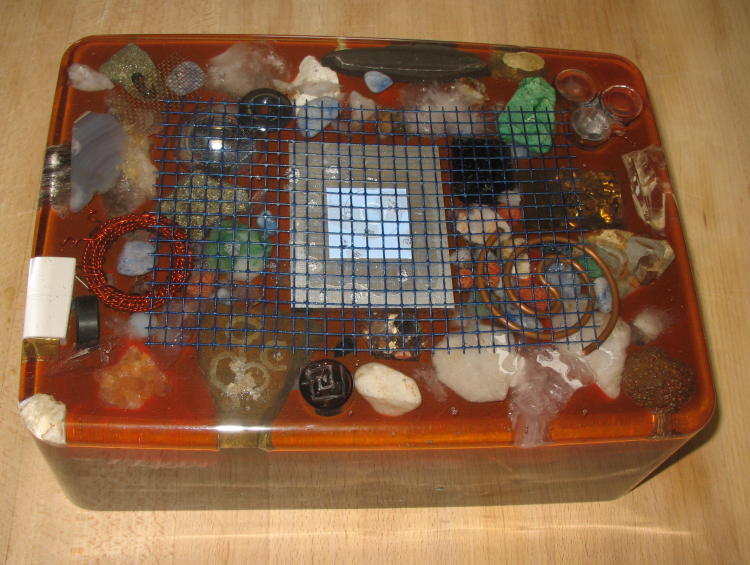
I made the above piece with no thought as to what it would look like when complete. Or which side would be the top.
Often a rock off your driveway is more appropriate and effective for something than an expensive gem. If you are drawn to a rock on the ground as you are walking along, grab it no matter how worthless it appears.
Get a few magnets of any type that crosses your path. Yes, pricey rare-earth magnets are good, but again, there are times when a cheap magnet from the hardware store is better. Get different shapes.
Get screws, bolts, nuts, washers. Especially 7/8" fine thread drywall screws; at least with me that's what they mostly have wanted pounds of. But also 1" fine thread, and in smaller quantities any screw may be desired. Lug nuts, odd scraps of metal, key rings, big nails.
It is a must to have some 1/4" mesh hardware cloth and some tin snips to cut it.
If you're walking down the street and see a lead weight that fell off a wheel and got run over a bunch of times, recognize that it is a gift from the universe. The Committee will request it at some time. Always be on the lookout for potentially useful stuff. Any kind of metal mesh, tubing, or foil. Pipe fittings, small bottles, test tubes, electronic parts, ball bearings, fishing weights,
used chainsaw files...
And don't forget biologicals. Seeds, roots, nuts, herb powders. Date pits have strong energy. There are several pgms that require resin with only turmeric.
Sometimes I will be guided to use mineral or herbal supplement tablets or capsules.
Maybe you will be guided to pick up a feather, a rodent's jawbone, a raccoon vertebra, a dead beetle. Someone once sent me a bunch of shark's teeth, and they all got used up!
Often I will drive by a hardware store or even supermarket and be guided to get some stuff. The Committee will pull me to the items: plumbing pieces, screws, wire, tubing, plastic food containers to use as molds...
Passively-used electronic items:
Very many electronic components have marked and distinctive scalar energies. When I first got into using electronic components in resin, I was hooking them up in circuits that I had crudely diagrammed out under guidance. This came out most excellent. However, this was a big headache and more work than necessary. Orgone doesn't travel linearly down the wires anyway. Everything in a device is already connected. It's just a question of how much conductivity, inductivity, impedance, etc. defines the degree of connectedness. (Pseudo-scientific babble to obscure the fact that I don't know what I'm talking about. Truly, I don't. One of the biggest mistakes a person can make when working with The Committee is to attempt to THINK.)
Over time things evolved to where I hardly ever connect the electronic components anymore, or just connect a few together.
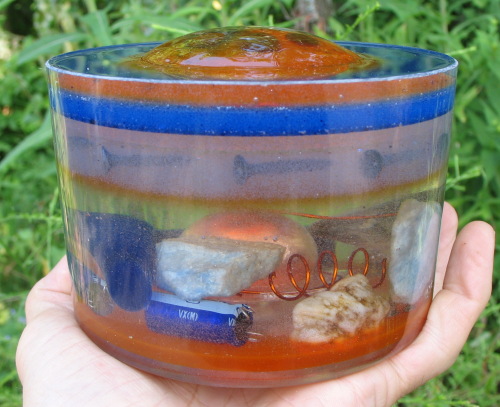 Usually now I just am guided to cut any leads down to a particular length and bend them in certain ways. For example, see the bottom center of this pic. There's a capacitor there with coiled wire ends.
Usually now I just am guided to cut any leads down to a particular length and bend them in certain ways. For example, see the bottom center of this pic. There's a capacitor there with coiled wire ends.
(Note also that there are NO SHAVINGS in this device. Not that there's anything wrong with shavings; one should collect as many kinds as one can. But usually I only use a bit here and there when I do use shavings. A lot of people have read that orgone devices should be 50% shavings. But when you program the resin that is not necessarily so.)
Using electronic components can get expensive. I have been guided to buy probably a couple thousand dollar's worth of capacitors, resistors, potentiometers, transistors, heat sinks, LED's etc. from catalogs on websites. And I have used up quite a lot of this stuff, and it was worth it to me to get the variety of energies to make very sophisticated devices.
Sometimes with potentiometers I am guided to tune one to a precise point and then embed it in resin.
I also keep some old circuit boards around from defunct electronic devices. Sometimes I am guided to remove components from an old board and use them. I don't even bother to unsolder them usually; I just snap them off.
Using active (electrified) electronics:
A lot of people come to me having read that the ultimate psi weapon is a Succor Punch or Power Wand (terms defined in glossary) and want me to make them a mobius coil to go around this big crystal they have, so that they can hook a 555-timer unit to it.
Well, that's ONE valid approach. But seldom is that the best thing to do with a crystal. Sometimes it is.
Personally I will put a mobius coil around a crystal if I am guided to make a particular coil for a particular crystal. And then this Succor Punch-like item will likely end up buried in resin and hooked up in a passive circuit.
I have never made a Power Wand of the type that is inside a 3" diameter pipe. These can be quite good. So can many other configurations that don't require expensive or hard-to-get parts.
There is no advantage to having a directional, phallic wand for remote work, as remote work is non-linear. Such a weapon might be appropriate, however for blasting physically close targets, e.g. the methheads next door.
Personally, my policy (because I have a huge and ever-expanding arsenal) has become to avoid wire connections and electrical requirements as much as practical.
In some instances it is crucial for the effective function of a unit for it to get electronic inputs. I have many great devices like this. [Update: As of Dec. 2012, I have 1 unit that still benefits significantly (24%) by being plugged in, and one that benfits 4%. The rest are no longer electrified.] But usually it is not necessary. Usually one can get comparable effectiveness with no juice input or wires to trip over.
Chem-busters: There is nothing wrong with the standard Croft configuration with 6 long 1" pipes. These work pretty well. However, I believe that with proper inspiration, one can do with much less in the way of copper pipe. The CB linked earlier was originally supposed to have 6 shorter pipes in a Croft hex configuration, but in the end the plans were modified so I just had 3 very short, fat copper pipe sections. In fact none of my CBs have long pipes except for one with one medium-long fat pipe, and yet, well, check out the chem-cloud video.
Grid-Blasters: Some tips here:magnets of any type I know of hold the Grid Program. So does any ferrite, magnetized or not. So do some other things, but these are usually preferred.Depending on the unit, the optimum number of copies of the Grid Pgm might be anywhere from 4 to 35. The Committee will put in the optimum number, which will likely all fit in a magnet or 2. This is a 2-part pgm, meaning each instance of it has to be attuned to a different person. By default 1 copy will be yours if you don't already have a copy, and the rest will be attuned to some of our ET allies, of which there are legions. If you have another person(s) you want some of the copies made out to, you can specify (assuming they are ensouled people).It is likely that you will be guided to do mostly Strontium-Barium formula in grid-blasters.If it is of any significant size, and has coils, it will likely work on the basis of induction, meaning you don't need to physically connect it to the electric grid.
Timing of construction: So maybe you want to make a nice grid-blaster/jailer/CB or something, and you've worked with The Committee some in the past, but now they don't seem to want to work with you on this project. Probably a matter of timing. Common TBs and ice cubes can be poured most any day (though there may still be occasional periods where it's not so good). But more sophisticated items are done at times The Committee deems optimal. I presume this has to do with astrological energies.
It is possible to dowse when in the future a project should be started.
Also, timing between pours is important. I work with epoxy that needs several hours between pours, but sometimes I am constrained from pouring as often as I could. That is, I'll be working on a large project in a big plastic food container mold, and I will only be "allowed" to pour a couple times a day, and maybe with very thin layers at that. I presume this is to stretch out the timing of the building process.
It is awkward to go too long between pours on such a project, as the hardened resin may want to shrink back from the mold slightly, meaning the slightest bump on the mold will break a space between the mold and the item such that the next pour may seep down the crack and mess up the item, at least cosmetically.
Also be aware that the bond of fresh epoxy poured onto a flat, smooth, days-old layer of epoxy, is not that strong.
However such cosmetic or structural considerations may be of no concern, especially if the item is to be later re-cast in a larger mold.
How long need one wait between layers with different programs? As long as it is physically set up enough to be maybe tacky but basically firm, you can pour. The Committee usually has no problem programming 2 things that are close together with different programs.
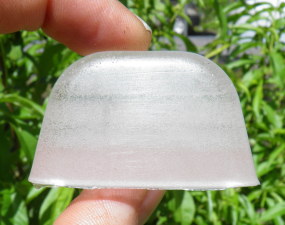 One interesting phenomenon I've found with resin-mix programs like the Strontium-Barium, Violet Flame, and water-charging programs, is that the more The Committee's experience with a pgm, the less powder mix it takes. Now I only have to faintly dope the mix with these programs. Depicted is a 4-way cube, circa late April 2011, that has (from rounded end to flat end) the following layers: ZPE, VF, H2O, and S-B.
One interesting phenomenon I've found with resin-mix programs like the Strontium-Barium, Violet Flame, and water-charging programs, is that the more The Committee's experience with a pgm, the less powder mix it takes. Now I only have to faintly dope the mix with these programs. Depicted is a 4-way cube, circa late April 2011, that has (from rounded end to flat end) the following layers: ZPE, VF, H2O, and S-B.
There is almost no strontium or barium in the S-B layer. The hint of pink is due to the iron oxide red. Almost no tulsi in the VF layer. But these cubes are just as good.
(If one wanted to confer UV-resistance, one could mix in some titanium dioxide and/or activated charcoal powder without harming anything.)
For comparison, here is a pic of early triple decker cubes (S-B, H20, VF) in which you can see that the water pgm layer is pretty clear, but the others opaque. Back then, more substance was needed in the mix.
Again, when making fancy, complex projects, I am often guided to use larger amounts of the powders for some reason.
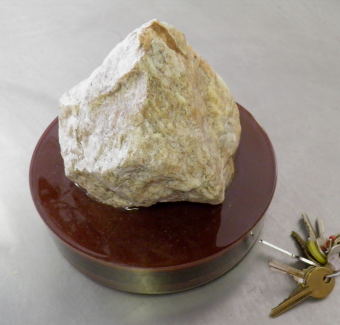 Multiple Functions: The tech is always improving. Just to let you know, for some time, The C has been able to stick additional functions into resin. E.g. you might be making a plain Strontium-Barium disk or something with nothing added, but they will also routinely stick in about 99% STQ plus some inductivity quality. These additional functions do not require space resources.
Multiple Functions: The tech is always improving. Just to let you know, for some time, The C has been able to stick additional functions into resin. E.g. you might be making a plain Strontium-Barium disk or something with nothing added, but they will also routinely stick in about 99% STQ plus some inductivity quality. These additional functions do not require space resources.
These days I often omit the hardware cloth that in the past I put in to achieve 100% STQ. Because in some cases, the unhampered epoxy may have more suitable energy flow or something. This does not always hold true.
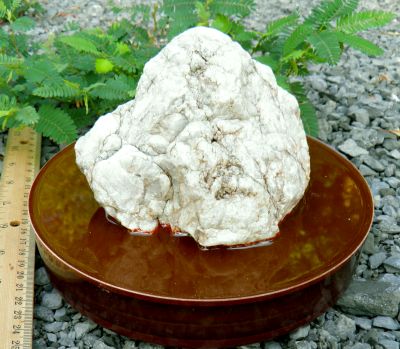 These 2 pieces were made in July and August, respectively, and have nothing in them other than a big quartzite and several layers of different flavors/programs of epoxy.
These 2 pieces were made in July and August, respectively, and have nothing in them other than a big quartzite and several layers of different flavors/programs of epoxy.
Both of these stones have extremely advanced programming, and could only have their power augmented by resin if I did things this exact way.
Loohan
next OTB
I never make any complex devices anymore except as I am guided to by The Committee.
Usually now I just am guided to cut any leads down to a particular length and bend them in certain ways. For example, see the bottom center of this pic. There's a capacitor there with coiled wire ends.
One interesting phenomenon I've found with resin-mix programs like the Strontium-Barium, Violet Flame, and water-charging programs, is that the more The Committee's experience with a pgm, the less powder mix it takes. Now I only have to faintly dope the mix with these programs. Depicted is a 4-way cube, circa late April 2011, that has (from rounded end to flat end) the following layers: ZPE, VF, H2O, and S-B.
Multiple Functions: The tech is always improving. Just to let you know, for some time, The C has been able to stick additional functions into resin. E.g. you might be making a plain Strontium-Barium disk or something with nothing added, but they will also routinely stick in about 99% STQ plus some inductivity quality. These additional functions do not require space resources.
These 2 pieces were made in July and August, respectively, and have nothing in them other than a big quartzite and several layers of different flavors/programs of epoxy.
 home coil info products ordering
home coil info products ordering